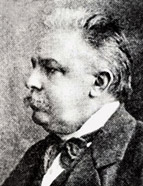

João Augusto Marques Gomes, son of Francisco Tomé Marques Gomes and Ana Cândida Barros de Almeida, was born in the parish of Vera-Cruz in Aveiro on 6 February 1853. He studied at the Aveiro high school, then called Liceu Nacional de Aveiro . He was a clerk in the Civil Government of Aveiro, but he didn't commit to a career in public administration since, in his words, he needed time to study art history, of which he was an enthusiast. In part, this enthusiasm came from the various documents and historiographical works his father and grandfather had left him, which may have increased his interest in history. He was also a journalist. He began his activity by publishing chronicles in his home district of Aveiro. He was an effective contributor to Distrito de Aveiro [Aveiro District] and O Campeão das Províncias [Champion of the Provinces] and also collaborated with other periodicals.
His first relevant historical study was Memórias de Aveiro [Memoirs of Aveiro], published when he was 22 years old (1875). In fact, Marques Gomes always showed a great concern for the history of his home city and its memory. Two major lines of thought are highlighted in this work: Aveiro's decadence and progress over the centuries—since Aveiro has always accompanied the moments of crisis and prosperity that Portugal has gone through throughout its history—which were characterized, however, by the crises that Europe also went through (the fall of the Roman Empire, the consequences of the struggles between Christians and Arabs in the Iberian Peninsula). Nevertheless, Aveiro began to gain some importance—albeit ephemerally, according to the author—during the reign of King Dinis and his son Afonso IV. This was due to the privileges given by the monarchs to the people of Aveiro ( Memórias de Aveiro , 1875, pp. XI-XIII).
This work is financed by national funds through FCT - Foundation for Science and Technology, I.P, in the scope of the projects UIDB/04311/2020 and UIDP/04311/2020.
